The month of March, when a brief spring in Bengal blends into the first signs of summer, is always associated by the author with the birthdays of her parents, Krishna (nee Rudra) and Pranab Guha-Thakurta. In the first of a two-part series, Tapati Guha-Thakurta historian, delves into her mother’s childhood years in Chittagong.
Ma’s earliest photograph is of a curly-haired dark-complexioned little girl, in a collared frock, standing in a lush garden, clutching a doll that has no clothes. The place is Chittagong, and the location is the bungalow on Percival Road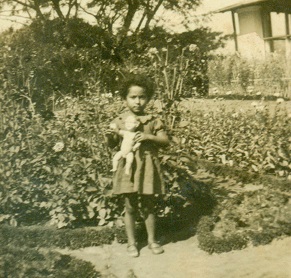 , College Hill, which was then the residence of the Principal of the Chittagong Government College. This was where Ma was born on 10th March, 1932, and where she lived for the first ten memorable years of her childhood, until her father, Rai Bahadur Padmini Bhushan Rudra, retired from the post of Principal in 1942.
, College Hill, which was then the residence of the Principal of the Chittagong Government College. This was where Ma was born on 10th March, 1932, and where she lived for the first ten memorable years of her childhood, until her father, Rai Bahadur Padmini Bhushan Rudra, retired from the post of Principal in 1942.
I have long been enamoured by this faded photograph – ever since it first emerged out of an old family album in the late 1990s, and was rearranged by Ma in groups of neatly labelled envelopes, to be stored in the lower racks of the Godrej almirah1 that had become her personal archive.
The photograph takes us back possibly to 1937, when she would have been five years old. Was this, I wonder, that very doll whose dress was removed to clothe her baby brother, Bapi (later Kalyan Rudra) who would have been born that year? Among the many stories Ma would regale us with, was this incident about the mid-wife coming into the room where she was sleeping, late at night, and removing the clothes from this one and only doll of hers for the new-born baby. It was a story that would upset her little grand-daughter, Mrinalini, so much that she would want to give her Didima2 a few dolls from her own large collection, to make up for the deep sense of deprivation she felt about her grandmother’s childhood. It was a lesson for both me and my daughter about the kind of simplicity and sharing that was typical of the lives that Ma and Baba led, as the younger ones in a large line of siblings, even as their fathers had established salaried professions. These were middle class families, where single incomes had to take care of both immediate and extended families of widowed aunts and cousins – where special dresses and dolls would have been few, and precisely because of that, greatly cherished.
Yet, as my mother would retrospect, these years in the Principal’s bungalow at Chittagong, were possibly the most of lavish of times for the Rudra family, into which she was born as the seventh child and the youngest daughter. Khuku (as she was called like every other little Bengali girl) grew up as a wild child of nature in the sprawling hilly grounds of this home – bonding as much with the flowering shrubs, mango and jackfruit trees among the many others she learnt to climb, as with their two pet sheep-dogs, Dora and Jolly, who would romp these grounds with her. The anglicised names of these dogs, she explained, were in keeping with her father’s profession as a teacher of English and his passion for the language and literature he taught. Her proper name, Krishna, was, according to her, one of many names given to her. Among her apocryphal stories was one where her five names – Khuku, Krishna, Ranja, Gopa and Bagha (the last meaning a tiger) — were written out on a outer wall of the house, as a punishment for the rebellious baby tiger of a girl she would have been. The home would have been a buzzing and boisterous place, especially by the time all nine siblings made up the family, and Khuku (alias Bagha) was clearly one of the most pampered and impetuous among the children.
A Rudra family photograph, from the winter of 1939-40, shows them all dressed up and posing for the camera, in what looks like the open grounds of the College Hill bungalow. My grandfather Padmini Bhushan Rudra, sitting on the extreme left with his second youngest son, Bapi, was then at the peak of his professional career, serving his second term as Principal of the Chittagong Government College, with the title Rai Bahadur3 to his credit. Born in 1888, an only son of his parents, he was a meritorious student who had matriculated at the age of twelve or thirteen (as was not uncommon in those days), had graduated in English from Dhaka College and had begun his career as a young teacher of English in the same college when he was barely nineteen, with many of his first students being much older than him. This was well before Dacca University came to be founded in 1921, with its large campus near the Ramna Maidan, spreading outwards from the edge of the congested old city. Dacca Government College was where he taught for over two decades, before he was transferred to the Chittagong Government College, possibly around 1930 – from where he moved from his faculty position in the English department to serve two consecutive terms as Principal of the College from 1933 to 1942. Next to him, seated on a separate chair is his beautiful young wife, Sarajubala, more than 15 years his younger, who carries in her lap their infant youngest son, Dipu (later Dipak Rudra) who was born just a few months before the taking of this photograph, on 23rd August, 1939.

The photograph takes us into the next generation of the Rudras. By then, the eldest daughter of the family, Renuka (he was Padmini Bhushan’s daughter by his first wife, and was barely seven years younger than her step-mother) was married to a young doctor from Ranchi, Dr. Sisir Kumar Basu. He sits here directly at the other end from his father-in-law, with their little daughter, Pakkush (Aloka), who was three months older than Bapi. It was very common in these large families for two generations of uncles and nieces to overlap in age. Ma would talk about how, for a long time, they never even knew that this eldest sister (Didimoni, as they all called her) was by another mother, about how she and this doctor Jamaibabu4 (who came to be called “Jambu” by all) indulged them with outings on every visit, and how their home in Ranchi[City in eastern India, now the capital of Jharkhand[/note] became the ready get-away place for the family, especially after they moved to Calcutta. By the time of this photograph, Ma’s two elder brothers, Bani Bhushan and Mani Bhushan would have finished school and been students of the same Chittagong Government College where their father was Principal. The next two brothers in line, Ahi Bhushan (Tawney) and Charu Bhushan (Khokon) would have been studying at the grand St. Placid’s High School in Chittagong. Ma’s second sister, Reba (Rebu) would have been in the senior-most classes at the well-known Khastagir Girl’s School, around the corner from the Government College, where Ma was also a student. Among the luxuries enjoyed by the family were a Principal’s personal car and a family chauffeur, who would ferry the younger children back and forth from their schools.
What always caught my attention in this family photograph was the fur-collared, buttoned and belted coat that my mother was wearing for this occasion. I now see that her niece, Pakkush, cosying up to her father, is wearing a similar baby coat. Such an outfit was, no doubt, another of Ma’s rare prized possessions, possibly a special indulgence for the little girls of the family. Striking in this photograph is the free mix of Western and Bengali formal attire, the dark jackets, shoes and socks of all the boys and men (with a tie adding to the stature of the head of the family) contrasted by the shirt and dhoti of the son-in-law, an attire that “Jambu” never deviated from till the end of his life. Adulthood, we know, came early in those days, especially for girls. Ma’s elder sister Reba, then fourteen and a half, is already a young lady in a saree, and it is only the tying back of their hair and the drape of the sari over their heads that marks out the two married women, her mother and her elder sister, who are seated on either side of her. By contrast, Khuku is still the little girl she was, her unruly hair neatly parted as she poses in what now looks like an outlandish coat. Whenever the subject of the coat came up, Ma would hasten to remind us about the chill of the winter months in the lush hilly tracts of Chittagong.
In Ma’s memories, there was always something idyllic about these years in Chittagong. As against the strictures of their ancestral home in Dhaka – where they we would go during the holidays – this home allowed for many freedoms and intermixing. The Dhaka house near Chandni Ghat was a place she associated with her aged grandfather, Kamini Bhushan Rudra (their house was in a road named after him) and two widowed Pishimas (father’s sisters) who, loving as they were, remained unbending about ritual observances, abstinence, and, not least of all, the separation of vegetarian and non-vegetarian kitchens.
Her young and talented mother, Sarajubala, would have savoured most the more lax and anglicised environment of her own household at Chittagong. Here, she trained in playing the sitar under a Muslim ustad, while her two elder sons, Bani and Mani, learnt their lessons on the tabla. This is when she also had the leisure to first take up the art of “sauce painting”, meticulously copying and enlarging European paintings from the beautiful half-tone block prints of these paintings that would appear in Bengali journals like Sahitya and Bharatbarsha. A touching-up technique used by artists in photographic studios, the sauce colouring gave her paintings the look of enlarged photographic reproductions. Her sitar playing was something she never returned to. But Sarajubala’s sauce paintings travelled with her from Chittagong to the many homes she would later live in, across different parts of Kolkata, and a few still remain in Rudra family homes. When we were growing up, our Didima’s culinary skills were legendary, as was her obsession with feeding family and guests with the most delectable of evening snacks, particularly her one-of-a-kind Dhakai paratha 5 and mangsher singara6, the latter carrying her special touch of neatly braided borders. Ma would recount, it was at their Chittagong home that Didima began to make roast chicken (then a forbidden meat in most Hindu homes) under the guidance of a Muslim bawarchi,7 and also took to making cakes, which would be taken to be baked in a nearby Jewish bakery.
In my mind, as in Ma’s stories, there were threads weaving together these many recollections. Two girls from this same Jewish bakery, that stood on a prominent roundabout within a few yards of the Government College, Cheroo and Kocher, were her friends at the Khastagir’s Girls School. As a harbour city on the banks of the river Karnaphuli, before it merged into the vast Bay of Bengal, Chittagong had a thriving ship-building industry and was then a cosmopolitan city with a confluence of many trading and religious communities.
St. Placid’s High School, established in 1867, had an adjacent church and graveyard, that Ma would often visit, where she learnt to make the sign of the cross in prayer, touching her head and shoulders. In her own Khastagir Girl’s School, there were two stalwart Bengali Christian teachers, whom they called Sona-Mashima and Mini-Mashima8 (their names were Suprobha Sarkar and Suroma Biswas), who were friends of her father and frequented their bungalow on the hill. Occasional afternoon teas at the home of these two imposing ladies were formal affairs, Ma would tell us – when she would be seated at a table with quarter plates and folded napkins, that she had to tie around her neck as she ate her sandwiches. These were small but important markers that set apart their lifestyle from the informal, never-ending family meals of her own home. She also remembered, not without a small degree of reproach, that despite their close acquaintances with the Rudras, Sona and Mini Mashima would show not the slightest indulgence in school to this naughty little daughter of Padmini Bhushan Rudra.
My grandfather’s life at Chittagong also seemed to have swung between many affiliations – as he kept going his responsibilities to his father, widowed aunts and their families in the Dhaka home alongside his professional circles at both Dhaka and Chittagong. His study in the Principal’s bungalow – a front entrance room lined with book shelves – was where he would receive his peers and colleagues. My uncle, Dipak Rudra, recalls that important Muslim politicians and intellectuals, like A.K.Fazlul Haque9, would visit him and, during the month of Ramadan, often break his fast at this study, bringing with him a basket of sweets, fruits, and old Dhaka’s famous bakarkhani roti10. Friendships and faiths in his life seemed to have crossed religious boundaries with ease. At the foot of College Hill, there was a small Sufi Pir dargah,11 which my Dadu would regularly visit, from where food would come to their home on the occasion of Urs festivals. Dadu had an abiding belief that it was the blessings of this Pir-Baba that always protected them, especially when the family, then residing in Pataldanga Street in north Kolkata, found itself in the worst areas of Hindu-Muslim rioting during the Great Calcutta Killings of 1946. In the last decade of his life, during the 1950s, when he was living in the home he had built with his life’s savings at the-then new neighbourhood of New Alipore, Padmini Bhushan Rudra would continue to visit a dargah in the Mominpur-Khidirpur area. It was his standing request to his favourite son-in-law, Gopal, my father Pranab Guha Thakurta, to take him once a month in our car to this Khidirpur dargah.
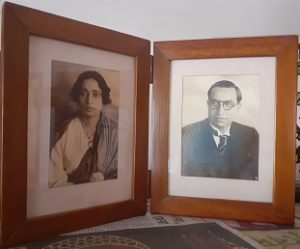

The time of my mother’s birth were the most turbulent and volatile years in Chittagong’s political history. Just two years before, on an Easter Friday that was 18 April 1930, a group of daring young men and one young women, led by the legendary revolutionary schoolteacher, Masterda Surjya Sen, had carried out one of the most audacious raids in India’s nationalist struggle. They had stormed the Police Armoury near the end-post of the Assam-Bengal Railways in the Pahartali area of Chittagong. This daring assault, soon to be suppressed, had thrown this harbour town at the easternmost periphery of undivided British India onto the centre stage of the revolutionary nationalism of those years. The next many months of 1930-31 was a time when the young revolutionaries went underground, when fierce guerrilla battles were being fought around the hills of the main city, and the colonial state was resorting to brutal repressive measures. Padmini Bhushan Rudra would later reflect on his own deep empathy for these young revolutionaries, especially for the young Kalpana Datta who joined the group – but regretted that he could never express his views as a British government servant. And my mother would recall that the years just after she was born – 1933-34 – was when Masterda, along with his prime aide, Tarakeshwar Dastidar, was arrested, given death sentences and hung in secrecy inside the Chittagong jail and their corpses unceremoniously dumped in the Bay of Bengal. The story circulated that, following the midnight hanging of Surjya Sen and Tarakeshwar Dastidar on 12th January, 1934, “the sun did not dawn” over the town of Chittagong, as the curtain finally came down on the legendary uprising. These were the inherited memories of these volatile years that Ma carried deep within herself, into her adulthood and old age.
It was in the midst of other equally turbulent times, at the end of 1942, when the Second World War was at its height, and Japanese bomber planes hovered over this town at the edge of empire, bordering the Arakan regions of Burma, that the Rudras left their home in Chittagong and returned to their ancestral home in Dhaka. This was the first of a series of relocations for the family. Krishna was admitted for a year to the renowned Eden Girl’s school of Dhaka, where her own mother, Sarajubala, had studied, three decades ago, before she was married off in 1918. Soon afterwards, came another move to Calcutta, in September 1944. This was when Padmini Bhushan Rudra, following his retirement from the Bengal Education Service, took up a position with the Union Public Service Commission in Calcutta – and the family moved to their two-storeyed rented house on Pataldanga Street, a narrow lane off Amherst Street and Harrison Road. It is from this home that my teenaged mother would walk through winding alleys to her new school, Victoria Institution on Upper Circular Road, from where she matriculated in 1948, and later, to Sanskrit and Presidency College where she enrolled for her graduation.

More than half a century later, as dementia clouded her short-term memory and her ageing brain began to play strange games with time, what remained most sharply most etched in Ma’s mindscape were a series of vignettes of these childhood years in Chittagong. It is when you never return to a place, never see it transform over the years, that a place, like a long-left behind time of your life, becomes frozen as a utopian site of memory. For the octogenarian, Krishna Guha Thakurta, Chittagong had become precisely such a place – a place of solace and retreat. As she would endlessly repeat her stories of her childhood, her accounts of incidents would often slightly change. And I became her memory-keeper of sorts, supplying names of people she would forget, or correcting sequences and time-frames, being the incorrigible historian that I am. Once, in 2011, when her granddaughter, Mrinalini, was making a short video called “Ghor” (Home) as a part of a. M.A. class assignment on the way memories of Partition are transmitted through generations, I asked Ma which Bengal would she consider her real home. Without hesitating for a minute, she said East Bengal. And where would you want to go back to most? Pat came her reply, Chatgna (the Bengali colloquial term for Chottogram, whose English name was Chittagong).
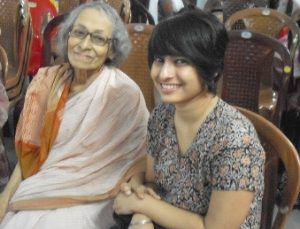
One of my great regrets was that I could never take Ma back to her Chatgna. It was two months after her passing that my daughter and I finally made our ‘pilgrimage’ to Chittagong in her memory in the last days of the March of 2016. We were shocked by the concrete and mortar city we drove through, one that had little if any connection with the open spaces and hilly environs that Ma would talk about, where rampant real-estate development had eaten into most of the hillsides. Only the Tiger Pass Road and the area of Pahartali, still the Police and Railway headquarters, retained a semblance of the picturesque Chittagong of the 1930s. Standing here, I tried to recreate the incidences of the daring Armoury Raid. It was a strange coincidence, one that gave me goosebumps that we were there at Pahartali, remembering Master-da on an Easter weekend.
It was by an immense stroke of luck that we met the Principal, Yasmin Akhtar, in the old red brick building of Chittagong Government College and University, and was told by her (much to our disbelief) that her residence continues to be the same bungalow on College Hill. She graciously asked her driver to take us to see the house, now called Adhyaksha Bhavan – an innocuous blue house, with an entrance verandah, on which many later additions must have been made. The grounds which would have once occupied practically one full side of the hill, had been reduced to a small-sized well-kept garden inside the walled complex. We felt immeasurably blessed to be standing in those same grounds where my mother had played as a little girl, where that Rudra family photograph would have been taken eighty years ago. Being Easter holiday time, we had to gently persuade the guards to let us wander through the empty corridors of the Khastagir Girls School and explore the vast compound of St. Placid’s School, whose exterior has remained largely unchanged, and then make our way to the graveyard at the back of the school and the open chapel with the Crucifix, where we prayed for Ma and felt engulfed by her ethereal presence.

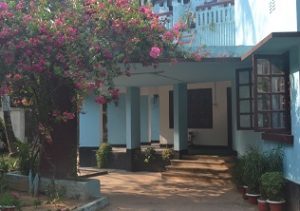

Perhaps, it was a good thing that Ma never returned to the place, and never confronted the invasion of the present in the dreamscape of her childhood. I would like to believe that her memories of Chittagong returned to her as a divine grace in the last hours of her life on that fateful winter afternoon of 27 January, 2016. As her end neared, Mrinalini quietly told me that she was praying that her Didima’s soul would now be free to roam all the places she avidly read about but never visited, and could return to the place of her birth. And I watched with amazement her feeble hands making the sign of the cross across her head and shoulder, as I removed all her life-support tubes and gave her my farewell embrace.
Tapati Guha-Thakurta, Professor of History, was the former Director of the Centre for Studies in Social Sciences, Calcutta. She lives in Kolkata.
Footnotes
- Steel wardrobe
- Grandma
- An honorary title that the British state awarded to eminent Indians
- Husband of an older sister
- A special kind of fried flat bread
- Samosa filled with meat
- Chef
- Older and respected Aunt
- First Prime Minister of undivided Bengal in pre independent India from 1937 to 1941
- A speciality of East Bengal, now Bangladesh
- Mausoleum of a Muslim saint
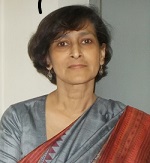
I had met Mashima but the stories she would share with me were all related to Santiniketan- where she went to college. Perhaps, that was because my parents lived in Santiniketan and were close friends of Bharati Datta who studied there with Mashima and Meshomoshai. There are so many wonderful moments in Tapati’s recounting – the reason why the doll had no clothes, the names of the little girl written on the wall, the inherited memories of the Chittagong Armoury Raid but I was moved most of all by the the beautiful and masterfully explored links between past and present that Tapati, daughter, historian and writer holds out for us to reflect on. History, after all, does and must begin at home.
As always Tapu’s narrations are ALL masterpieces! This was extra special for me reading about mashima. Will wait for your writing on meshomashai.
My dear sister Tapu, my second and closer read of what you have written so brilliantly about Ma, made me realise what an amazing historian and raconteur you are. Bits and pieces of what I had heard – and what I had ignored and what I, in my arrogance, chose not to recall or remember – came back vividly as a coherent narrative of someone whose flesh and blood I am. I cannot thank you more for what you have written. The manner in which you have woven history and well-known facts into her life and the lives of her family members was simply superlative – forgive me the effusive praise for that was just the older brother in me who bullied you, now atoning and expressing regrets while reminiscing and reliving the past we can never return to and for bringing tears to my eyes. And like all children, I will forever regret why I didn’t spend more time with Ma and didn’t listen to her advice and constructive criticism. I want to recall one particular many-layered lesson I learnt from an episode she recalled, a throwback from the Great Bengal Famine. She always taught us never to waste food. At her household, stainless steel plates had come for the first time (after earthen plates and banana leaves) and by the time Ma had used her fingers to remove every bit of (finger-licking tasty) food from her plate (as was always her wont) it appeared as if the plate was a freshly washed one. When the purutmoshai (or head cook) picked up her plate he thought it had not been used at all. Ma intervened and told him that her plate was etho (or jhoota in Hindi) or one that had already been used for eating. The purutmoshai, shocked that he had been unknowingly “contaminated,” dropped the steel plate on the ground making a loud clanging sound! Keep writing, keep remembering. Your thoughts are precious. Lots of love. Dada
Thank you, Dada. There was so much more to recall and write, about Ma’s Chittagong years – hope this can be the beginning of a larger project.
One small correction, the head cook (Uriya) in their Dhaka house would have been called “thakur-moshay” not “purut-moshay”.
Right you are – thakurmoshai not purutmoshai.
It was wonderful to delve into the life of someone, who had become a very dear friend. The “in-law” tag didn’t matter. She was my friend. She seldom spoke about herself, and hence it is a pleasure that she’s come back to me, through Tapu’s narration. More complete–as a person –in addition to being a perfect friend!
It was a pleasure to read about Krishnamashi’s childhood woven so nicely by her daughter, Tapu ( Tapati Guhathakurt) with threads from the history of Purbo Bango during that time. Tapati’s remarkable story telling ability transports the reader immediately to this forgotten era. Looking forward to reading Part two.